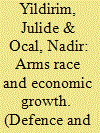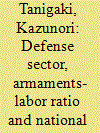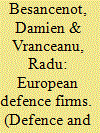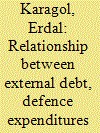| Srl | Item |
| 1 |
ID:
072644


|
|
|
|
|
| Publication |
2006.
|
| Summary/Abstract |
The hostility between India and Pakistan is believed to have led to an arms race between the two countries, which might have contributed to their retarded economic growth. This paper investigates this twin problem of arms race and economic growth for the time period 1949-2003. The empirical results suggest that there is a mutual causal relationship between the military expenditures of India and Pakistan. Even though military expenditure does not Granger cause economic growth in Pakistan, there is causality from military expenditure to economic growth in India. A VAR analysis revealed that military expenditure hinders economic growth in India in the long-run, but it has a growth promoting effect in the short-run.
|
|
|
|
|
|
|
|
|
|
|
|
|
|
|
|
| 2 |
ID:
072647


|
|
|
|
|
| Publication |
2006.
|
| Summary/Abstract |
This paper analyzes a national defense economy in which the army reduces the risk of attack and damage. The results show that it is important how countries or people feel about damage to military personnel, citizens and wealth from attack. The feeling determines the optimal levels of arms procurement and army personnel. It also affects international trade. It is found that labor (armaments) input into the military sector is not always decreased following an increase of wage (armaments price). The model suggests that conscription affects army expenditure and international trade.
|
|
|
|
|
|
|
|
|
|
|
|
|
|
|
|
| 3 |
ID:
072643


|
|
|
|
|
| Publication |
2006.
|
| Summary/Abstract |
After the fall of the Berlin Wall, European governments adopted a hands-off policy towards the defence industrial base, in an attempt to increase the sector's efficiency and reactivity. In this context, one topical issue is how to motivate defence firms to apply for private rather than public finance. Since banks have no prior experience with European defence firms, a problem of asymmetric information may block this transition. The problem is analysed within the framework of a game between defence firms and banks. It is shown that the Bayesian Equilibrium might correspond to a situation where low-risk firms prefer the state-financed scheme; yet, in a perfect information set-up, the same firms would apply for bank credit. In order to facilitate the transition to private finance, the government might decide to subsidize investors who agree on financing defence firms; the state aid should be made available during a transitory learning period.
|
|
|
|
|
|
|
|
|
|
|
|
|
|
|
|
| 4 |
ID:
072645


|
|
|
|
|
| Publication |
2006.
|
| Summary/Abstract |
This paper extends the Looney and Frederiksen (1986) study and investigates the relationship among external debt, defence expenditures and GNP in Turkey for 1960-2002. After applying cointegration analysis of a multivariate system of equations, impulse response functions and variance decomposition are estimated. The impulse response functions indicate that defence expenditures have a positive effect on external debt stock. Moreover, impulse response of GNP to defence expenditures tended to hike slightly within two years ahead, and dipped sharply by two years, and thereafter continued at a positive level.
|
|
|
|
|
|
|
|
|
|
|
|
|
|
|
|
| 5 |
ID:
072641


|
|
|
|
|
| Publication |
2006.
|
| Summary/Abstract |
Airframe fatigue has emerged as a primary determinant of tactical aircraft service life. To investigate the impact of various operational scenarios on airframe fatigue and aircraft stocks, we develop an econometric model of fatigue and arrest landing accumulation for US Naval aircraft. Model forecasts suggest that fatigue-related attrition threatens to reduce inventories below the level needed to meet operational commitments before planned replacements are available. Changes to training regimes could mitigate the shortfall, but it is likely that acquisition schedules will have to be accelerated, or current service life extension programs expanded to maintain inventories in the future.
|
|
|
|
|
|
|
|
|
|
|
|
|
|
|
|